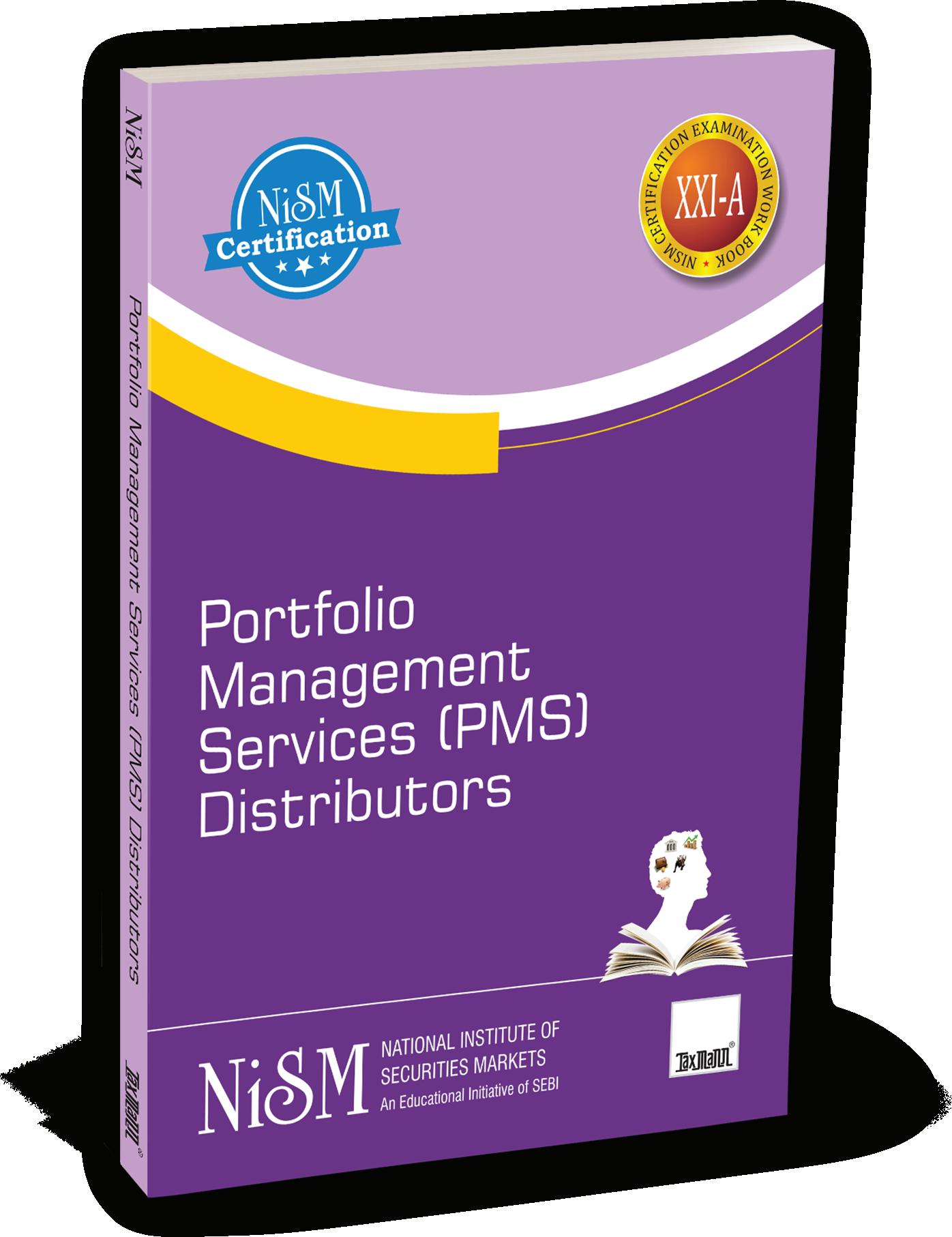© NATIONAL INSTITUTE OF SECURITIES MARKETS, MUMBAI, 2025
PRINTING AND PUBLISHING RIGHTS WITH THE PUBLISHER
All rights reserved. No part of this publication may be reproduced, stored in or introduced into a retrieval system, or transmitted in any form or by any means (electronic, mechanical, photocopying, recording or otherwise), without the prior written permission of National Institute of Securities Markets.
Any person who does any unauthorised act in relation to this publication may be liable to criminal prosecution and civil claims for damages.
While every care has been taken in compiling the information contained in this publication, National Institute of Securities Markets accepts no responsibility for any errors or omissions.
Workbook Version : March 2025
Price : ` 445
Published by :
Taxmann Publications (P.) Ltd.
Sales & Marketing :
59/32, New Rohtak Road, New Delhi-110 005 India
Phone : +91-11-45562222
Website : www.taxmann.com, E-mail : sales@taxmann.com
Mumbai
35, Bodke Building, Ground Floor, M.G. Road, Opp. Railway Station, Mulund (West), Mumbai-400080
Ph : +91-22-25934806, 25934807, 25934809; Mobile : 09322247686, 9619668669, 7045453844/45/48/51
E-mail : sales.mumbai@taxmann.com; nileshbhanushali@taxmann.com
Regd. Office : 21/35, West Punjabi Bagh, New Delhi-110 026 India
Printed at : Tan Prints (India) Pvt. Ltd.
44 Km. Mile Stone, National Highway, Rohtak Road, Village Rohad, Distt. Jhajjar (Haryana) India
E-mail : sales@tanprints.com
DISCLAIMER
The contents of this publication do not necessarily constitute or imply its endorsement, recommendation, or favoring by the National Institute of Securities Markets (NISM) or the Securities and Exchange Board of India (SEBI). This publication is meant for general reading and educational purpose only.
The statements/explanations/concepts are of general nature and may not have taken into account the particular objective/move/aim/need/circumstances of individual user/reader/organization/institute. Thus NISM and SEBI do not assume any responsibility for any wrong move or action taken based on the information available in this publication.
Therefore before acting on or following the steps suggested on any theme or before following any recommendation given in this publication user/reader should consider/seek professional advice.
The publication contains information, statements, opinions, statistics and materials that have been obtained from sources believed to be reliable and the publishers of this title have made best efforts to avoid any errors. However, publishers of this material offer no guarantees and warranties of any kind to the readers/users of the information contained in this publication.
Since the work and research is still going on in all these knowledge streams, NISM and SEBI do not warrant the totality and absolute accuracy, adequacy or completeness of this information and material and expressly disclaim any liability for errors or omissions in this information and material herein. NISM and SEBI do not accept any legal liability what-so-ever based on any information contained herein.
While the NISM Certification examination will be largely based on material in this workbook, NISM does not guarantee that all questions in the examination will be from material covered herein.
CHAPTER 1 INVESTMENTS
CHAPTER 2
INTRODUCTION TO SECURITIES MARKETS
CHAPTER 3
INVESTING IN STOCKS
CHAPTER 4
INVESTING IN FIXED INCOME
CHAPTER 5 DERIVATIVES
5.7
CHAPTER 6
MUTUAL FUND
6.5
6.7
6.8
CHAPTER 7
CHAPTER 8
CHAPTER 9
PORTFOLIO MANAGEMENT PROCESS
CHAPTER 10
CHAPTER 11 TAXATION
CHAPTER 12
REGULATORY, GOVERNANCE AND ETHICAL ASPECTS OF PORTFOLIO MANAGERS
12.1 Prevention of Money Laundering Act,
12.2 SEBI (Prohibition of Insider Trading) Regulations, 2015
12.3 SEBI (Prohibition of Fraudulent and Unfair Trade Practices Relating to Securities Market) Regulations, 2003
12.4 SEBI (Portfolio Managers) Regulations, 2020
12.5 Best Practices for Portfolio Managers
CHAPTER 10
PERFORMANCE MEASUREMENT AND EVALUATION OF PORTFOLIO MANAGERS
LEARNING OBJECTIVES:
After reading the chapter, reader should:
Understand different ways of calculating the return
Understand different ways of calculating the risk
Understand different ways of calculating the risk-adjusted return
The importance of Benchmarking and peer group analysis
Performance reporting to the Investor by PMS
Global Investment Performance Standards
10.1 Parameters to define performance – Risk and return
The main issue in performance measurement and evaluation is the human tendency to focus on the return, the investment has earned over a period of time with little regard to the risk involved in achieving that return. Proper performance measurement should involve recognition of both return and risk of investments.
10.2 Rate of return measures
The most vital statistic in measuring the performance of a portfolio is the rate of return. Rate of return has many possible definitions. However, there is one possible definition for each purpose. So, one should make effort to obtain clarity about the
PERFORMANCE MEASUREMENT AND EVALUATION
purpose for which the performance is to be measured and then look at an appropriate return measure.
10.2-1 Holding period return
The most straightforward rate of return is the holding-period-return (HPR), popularly known as total return or point-to-point return. It equals the income generated by an investment plus the change in value of the investment during the period the investment is held, over the beginning value of the investment, expressed as a percentage per annum.
For example, If the market value of an investor’s portfolio on 1 April, 2018, is Rs.1,00,000, and on 31 March, 2019 the market value of the same portfolio stands at Rs.1,20,000, the investor would have achieved a holding-period return equal to 20%. In general, we can use Equation (1) to compute holding-period returns.
HPR = (E-B)/B ………………. Equation 1
HPR = ((120000-100000))/100000 = 20%
Further, assume that during the same period the investor has received Rs. 5000 by way of dividend and interest income, then:
HPR = (I + (E -B))/B …………………. Equation 2
HPR = (5000 + (120000-100000))/100000 = 25%
Where,
HPR = Holding-period return
I = Income
E = Ending Value
B = Beginning Value
This measure assumes that all income distributions are made at the end of the year. In spite of this limitation, total return measure is widely used and generally accepted indicator of performance. This is considered as the starting point of performance measurement exercise.
PERFORMANCE MEASUREMENT AND EVALUATION
10.2-2 Time weighted Rate of Return (TWRR) versus Money weighted Rate of return (MWRR)
Let us now consider rate of return over multiple holding periods. Suppose a portfolio has generated the following annual holding period return from 2015 through 2019 (Table 10.1):
TABLE 10.1: FIVE YEAR HOLDING PERIOD RETURNS
Suppose further that the investor has invested Rs. 75,000 in this portfolio by making contributions at the beginning of the year as follows (Table 10.2):
TABLE 10.2: INVESTMENT CONTRIBUTIONS
At the end of 2019, the investments would have grown to the value of Rs. 105,920.31 as shown below:
TABLE 10.3: COMPUTATION OF RETURNS AND PORTFOLIO VALUE AT THE BEGINNING AND END OF THE PERIOD
PERFORMANCE MEASUREMENT AND EVALUATION
made at the beginning of the year in
the period
What is the rate of return generated during the period of five years?
By discounting the terminal value of the investment i.e. 105,920.31 to cashflow contributions made, internal rate of the return for the same can be calculated.
= –
(Internal Rate of Return) IRR = 15.15%
IRR is also referred as MWRR (Money Weighted rate of return). Financial calculators and spreadsheet have inbuilt function for solving the IRR. MWRR is the annual rate of return at which the cumulative contributions grow over the measurement period. MWRR depends on the timing of the cash flow. If we reverse the order of contributions of the same amount i.e. Rs. 75,000, as shown in Table 10.4, MWRR would change to 10.21%.
TABLE 10.4: CALCULATION OF MWRR
= –
PERFORMANCE MEASUREMENT AND EVALUATION
–
(1 + r)1 (1 + r)2 (1 + r)3 (1 + r)4 (1 + r)5
MWRR or IRR = 10.21%
Alternatively, in order to calculate the underlying investment performance without being influenced by the timing of cash flow, TWRR can be calculated.
The Global Investment Performance Standards (GIPS) glossary defines timeweighted rate of return as a “calculation that computes period by period returns on an investment, and removes the effects of external cash flows, which are generally client driven, and best reflects the portfolio manager’s ability to manage assets according to a specified strategy or objective.”
TWRR is the compound rate of growth over the stated period. In TWRR, portfolio will be valued every time there is an external cash flow. If there is no external cash flow, TWRR is equivalent of HPR. When there is an external cash flow, TWRR requires computing a set of return for each period. These subperiod returns will be linked together to compute TWRR for the evaluation period.
Table 10.5 gives the contribution made by the investor along with the portfolio value for five years period.
In this example, there are five sub periods. First step towards calculating the TWRR is to calculate each period return as shown in Table 10.6 using equation 1 i.e. (E-B)/B.
TABLE 10.5: CONTRIBUTIONS MADE BY INVESTOR AND PORTFOLIO VALUE
PERFORMANCE MEASUREMENT AND EVALUATION
TABLE 10.6: CALCULATING RETURNS FOR EACH PERIOD
Investment made at the beginning of the year in Rs.
Portfolio Value at the end of the period in Rs.
Portfolio Value at the beginning of the year in Rs.
The next step is to link these five subperiod return together. For chain linking these subperiod return, we have to calculate wealth relatives. Wealth relative is ending value of one unit of money. Hence, what needs to be done to create wealth relative is to add one to each period return, as shown in Table 10.7.
TABLE 10.7: RETURNS MADE AND WEALTH RELATIVE
The next step is to create a cumulative wealth relative for the entire evaluation period by multiplying each period wealth relative as shown below.
Cumulative wealth relative = 0.95 × 0.848 × 1.081 × 1.3075 × 1.1765 = 1.3396
Cumulative wealth relative tells us what one rupee has grown over a period of time, in this case five-year period. In this example one rupee has become Rs.1.3396 in a period of five years. The compound annual return can be calculated as: TWRR=(Cumulative wealth relative^(1/n))-1 TWRR = (1.3396 ^ (1/5)) - 1 = 6.021%
PERFORMANCE MEASUREMENT AND EVALUATION
The TWRR is the same as geometric return
Note that unless the subperiods constitute exactly one year, time-weighted rate of return will not be expressed as an annual rate, and we have to annualize the return.
SEBI (Portfolio Managers) Regulation, 2020 prescribes discretionary portfolio managers to disclose performance using ‘Time Weighted Rate of Return’ for the immediately preceding three years. For illustration see Box 10.1.
Box 10.1: Calculation of Time-Weighted Rate of Return Steps to Compute Individual Portfolio TWRR:
1. Begin with market value at the beginning of the period.
2. Move forward through time towards the end of the period.
3. Compute the market value of the portfolio immediately before the contribution to/ withdrawal from the portfolio.
4. Calculate a sub-period return for the period between the valuation dates i.e. the dates corresponding to the contribution and/or withdrawal dates using the formula: (Ending Market Value - Beginning Market Value - Contribution + Withdrawal) ÷ (Beginning Market Value + Contribution - Withdrawal)
5. Repeat steps 3 and 4 for each contribution and/or withdrawals.
6. When there are no more contributions and/or withdrawals, calculate a sub- period return for the last period to the end of the period market value.
7. Compound the sub-period returns by taking the product of (1+sub-period returns). This is called geometric linking or chain linking of the sub-period returns.
8. Subtract 1 from the product value as arrived at in step 7 above.
9. Express the result as per 8 above in percentage terms to get the TWRR for the time period under evaluation.
Example:
An account is funded on 1-Jan-2019 by an amount 50,00,000. On 1-Mar-2019, client contributed additional 20,00,000. The market value of the account as on 28-Feb-2019 is 49,00,000. On 1-Oct-2019, the client withdrew an amount of 10,00,000 from the account. The market value of the account on 30-Sep-2019 was 75,00,000. The market value of the account on 31-Dec-2019 was 70,00,000.
Rs. 445/-
PORTFOLIO MANAGEMENT SERVICES (PMS) DISTRIBUTORS
AUTHOR : National Institute of Securities Markets (NISM) | An Educational Initiative of SEBI
PUBLISHER : Taxmann
DATE OF PUBLICATION : April 2025
EDITION : Workbook Version - March 2025
ISBN NO : 9789364551366
NO. OF PAGES : 296
BINDING TYPE : Paperback
DESCRIPTION
Portfolio Management Services (PMS) Distributors provide a clear roadmap for understanding PMS distribution's fundamentals, operations, and regulations. This concise guide blends theoretical concepts with practical illustrations, equipping readers to navigate securities markets, design portfolio strategies, and meet compliance standards. This book is intended for the following audience:
• Aspiring PMS Distributors
• Employees of Portfolio Managers and Distribution Houses
• Financial Advisors and Wealth Managers
• Students and Researchers
The Present Publication is the March 2025 Workbook Version, developed in collaboration with the Certification Team of NISM and Dr Rachana Baid, Dr Kameshwar Rao and Dr Kishore Rathi. It is published exclusively by Taxmann, with the following noteworthy features:
• [Aligned to NISM Certification Requirements] Meets SEBI's benchmark for PMS distributors
• [Comprehensive Coverage] Delves into investments, securities markets, portfolio managers' functions, performance evaluation, taxation, and more
• [Lucid and Practical Content] Includes practical examples, caselets, and illustrations
• [Authored & Reviewed by Industry Experts] Ensures authoritative and up-to-date guidance
• [Compliance & Ethical Focus] Provides insight into SEBI regulations, governance, and professional ethics
• [Step-by-step Operational Guidance] Covers onboarding, disclosures, fees, redressal mechanisms, and day-to-day operational tasks
ORDER NOW













